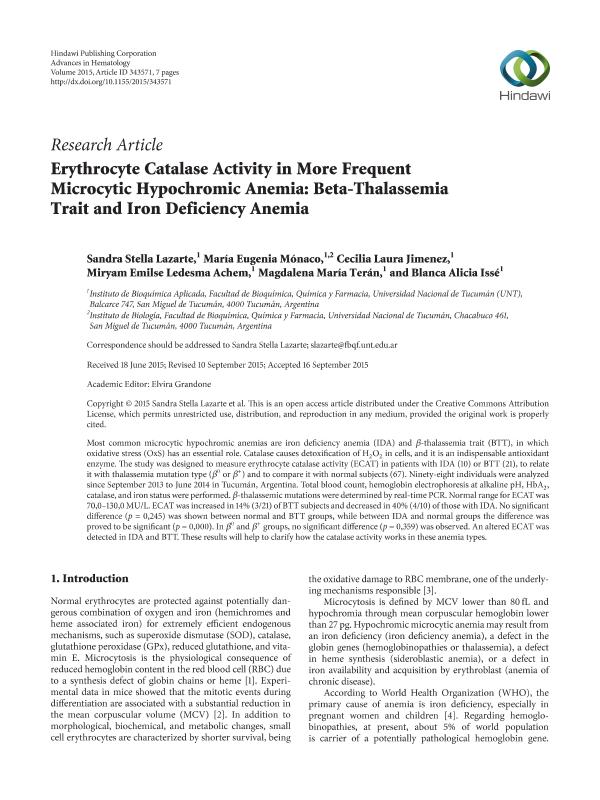Artículo
Erythrocyte Catalase Activity in More Frequent Microcytic Hypochromic Anemia: Beta-Thalassemia Trait and Iron Deficiency Anemia
Lazarte, Sandra Stella; Monaco, Maria Eugenia; Jimenez, Cecilia Laura; Ledesma, Miryam Emilse; Teran, Magdalena María ; Isse, Blanca Alicia de Los Angeles G.
; Isse, Blanca Alicia de Los Angeles G.
 ; Isse, Blanca Alicia de Los Angeles G.
; Isse, Blanca Alicia de Los Angeles G.
Fecha de publicación:
10/2015
Editorial:
Hindawi Publishing Corporation
Revista:
Advances in Hematology
ISSN:
1687-9104
e-ISSN:
1687-9112
Idioma:
Inglés
Tipo de recurso:
Artículo publicado
Clasificación temática:
Resumen
Most common microcytic hypochromic anemias are iron deficiency anemia (IDA) and β-thalassemia trait (BTT), in which oxidative stress (OxS) has an essential role. Catalase causes detoxification of H2O2 in cells, and it is an indispensable antioxidant enzyme. The study was designed to measure erythrocyte catalase activity (ECAT) in patients with IDA (10) or BTT (21), to relate it with thalassemia mutation type (β0 or β+) and to compare it with normal subjects (67). Ninety-eight individuals were analyzed since September 2013 to June 2014 in Tucumán, Argentina. Total blood count, hemoglobin electrophoresis at alkaline pH, HbA2, catalase, and iron status were performed. β-thalassemic mutations were determined by real-time PCR. Normal range for ECAT was 70,0-130,0 MU/L. ECAT was increased in 14% (3/21) of BTT subjects and decreased in 40% (4/10) of those with IDA. No significant difference (p=0,245) was shown between normal and BTT groups, while between IDA and normal groups the difference was proved to be significant (p=0,000). In β0 and β+ groups, no significant difference (p=0,359) was observed. An altered ECAT was detected in IDA and BTT. These results will help to clarify how the catalase activity works in these anemia types.
Palabras clave:
GEN HFE
,
BETA TALASEMIA
,
MUTACIONES
,
ESTRES OXIDATIVO
Archivos asociados
Licencia
Identificadores
Colecciones
Articulos(CCT - NOA SUR)
Articulos de CTRO.CIENTIFICO TECNOL.CONICET - NOA SUR
Articulos de CTRO.CIENTIFICO TECNOL.CONICET - NOA SUR
Citación
Lazarte, Sandra Stella; Monaco, Maria Eugenia; Jimenez, Cecilia Laura; Ledesma, Miryam Emilse; Teran, Magdalena María; et al.; Erythrocyte Catalase Activity in More Frequent Microcytic Hypochromic Anemia: Beta-Thalassemia Trait and Iron Deficiency Anemia; Hindawi Publishing Corporation; Advances in Hematology; 2015; 10-2015; 1-7
Compartir
Altmétricas



